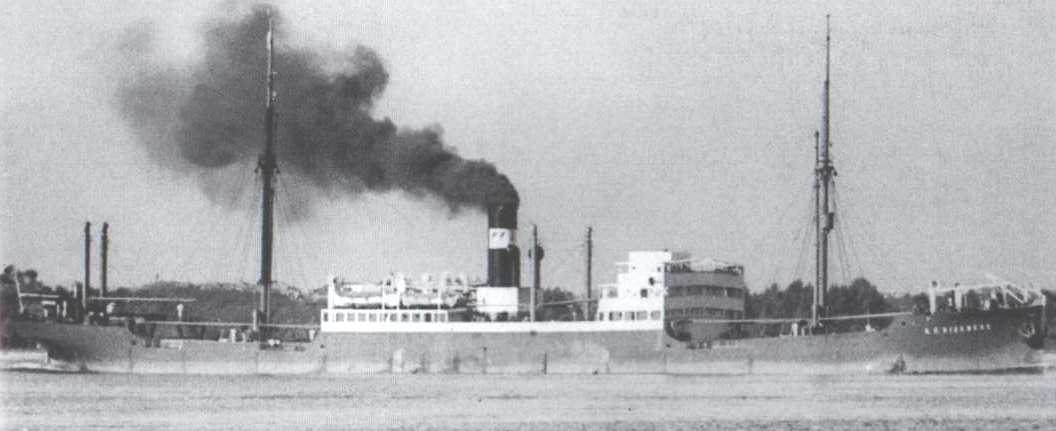KAKYAKUSEN
 (TEIFUKU MARU former R. C. RICKMERS)
(TEIFUKU MARU former R. C. RICKMERS)
Transport TEIFUKU MARU:
Tabular Record of Movement
© 2010 Bob Hackett, Peter Cundall and Erich Muehlthaler
E 1920:
Bremerhaven-Geestemunde, Germany. Laid down at Norddeutsche Werft GmbH, building number 172, as a 5,163-ton (later 5,198 grt) passenger-cargo ship for the Rickmers-Linie mbH, Hamburg.
10 March 1921:
Launched and named R.C. RICKMERS.
8 June 1921:
Officially delivered to the Rickmers-Linie mbH and placed in service on their Genoa, Italy to New York route; port of registry Hamburg.
12 October 1921:
On arrival in New York, two of R. C. RICKMERS' crew are arrested on charges of attempting to smuggle $15,000 of cocaine into the city.
1922:
Rickmers-Linie mbH resumes line service to the Far East.
20 August 1925:
R. C. RICKMERS arrives in Jeddah, Kingdom of Hejaz (now Saudi Arabia) carrying six second-hand Airco (de Havilland) DH. 9 light bomber biplanes with new Siddeley Puma engines and twelve Lewis machine guns, 120 cases of ammunition and 500 high-explosive and gas bombs. The whole consignment is supplied by Steffen & Heyman of Berlin, Germany. The main purpose of the Hejaz Air Force is a means to attack the hostile forces of the inland Kingdom of Nejd (now also part of Saudi Arabia) .
16 August 1930:
Departs Antwerp, Belgium for Hamburg.
23 August 1930:
Departs Hamburg for Port Swettenham and Singapore, Malaya, Iloilo and Manila, Philippines, Hong Kong, Kobe, Yokohama, Shanghai, Chemulpo, Dairen (former Port Arthur), Manchuria and Chinwangtao, China.
1931:
Shanghai. Three Junkers K47 fighters manufactured by AB Flygindustri, plus weapons and ammunition, are shipped from Hamburg to Canton, China on R. C. RICKMERS, but are confiscated by Shanghai customs and handed over to the Nanking Government.
1934:
Receives radio call sign DHTR.
25 November 1938:
Departs Antwerp, Belgium.
1 December 1938:
Departs Hamburg for the Far East.
23 August 1939:
Departs Hong Kong for Dairen.
30 August 1939:
Departs Shanghai for Kobe under Captain F. Raupach.
6 September 1939:
Arrives at Kobe and laid up. Being an 18-year old ship, she is considered unsuitable for fitting out as a blockade runner.
27 September 1939:
The German consulate general at Kobe suggests the ship be sold to one of several prospective Japanese customers. The question of acknowledgement of such a change of flag by England is thought to be avoidable because R. C. RICKMERS is well suited for coastal shipping in Japanese homewaters, but a sale is not made.
February 1940:
Kitagawa Sangyo Kaiun K. K. of Osaka attempts to charter R. C. RICKMERS for employment in the Kyushu-Kobe coal trade. Due to unknown reasons, the attempted charter fails.
8 December 1941: The Pacific War Begins:
Kobe. R. C. RICKMERS is still laid up.
December 1941:
R. C. RICKMERS is officially confiscated by the German Government and placed at disposal of the German Naval Attaché at Tokyo, Vizeadmiral (later Admiral) Paul Wennecker (former CO of Panzerschiff DEUTSCHLAND/LÜTZOW) and Deutscher Admiral Ostasien (German Admiral, East Asia) who time charters the ship to the Japanese Government´s wholly owned Teikoku Senpaku K.K. (Imperial Steamship Co.), Tokyo. Renamed TEIFUKU MARU. and assigned signal letters JWJQ, port of registry Tokyo.
20 December 1942:
Off Inubosaki. LtCdr (later Rear Admiral) Roy S. Benson's USS TRIGGER (SS-237) lays a second mine field a few miles north of Tokyo Bay.
22 December 1942:
Off Nojimasaki, near Tokyo Bay. At 1336 (K), lookouts aboard TRIGGER sight the smoke of a ship approaching from Uraga (near Yokosuka Port). Benson decides to make a surface attack. He fires a spread of three torpedoes and gets one hit forward of the bridge. The dazzle-camouflaged target starts to settle by the bow.
TRIGGER's crew spot about six seaplanes in the area, including one right over the target. Nevertheless, Benson fires a stern torpedo at TEIFUKU MARU. When last seen, the ship is awash forward with her screws nearly out of the water. [1]
28 December 1942:
Hokkaido. At 0910, departs Muroran carrying 7100 tons of coal in an unnumbered convoy consisting of TEIFUKU, WAKATSU and TAMASHIMA MARUs with an unknown escort.
29 December 1942:
7 km from Inubozaki Lighthouse, Chiba Prefecture. At 0910, TEIFUKU MARU is hit in hold No. 5 by what is thought to be a torpedo, but possibly is a mine laid by TRIGGER on 20 December at 35-45N, 140-54E. Although taking water, TEIFUKU MARU's captain manages to beach her 800 meters N of Choshi Harbor flood marker. [2]
4 January 1943:
Pounded by breakers and a severe gale, the beached wreck of TEIFUKU MARU is officially abandoned and considered a constructive total loss.
Authors' Note:
[1] It seems incredible, but true, that in 1942 TRIGGER laid mines and attacked ships on the surface just off Tokyo Bay and then loitered in the area for days. This speaks volumes about the state of the IJN's ASW forces at the time, not to mention the courage of the USN's submariners.
[2] There is a discrepancy between Japanese and American sources. Japanese sources claim TEIFUKU MARU was lost on 29 December not 26 December 1942.
Bob Hackett, Peter Cundall and Erich Muehlthaler
Back to
Ex-German Merchants in Japanese Service





